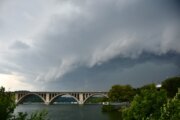A hole-by-hole look of Royal Troon, site of the 152nd British Open on July 18-21:
No. 1, 366 yards, par 4
A gentle opening hole, especially with the prevailing wind at the player’s back. There is out-of-bounds to the right and two bunkers on either side of the landing zone, assuming players hit iron off the tee. Some might try to drive the green in dry, favorable conditions. The green is slightly elevated with a narrow opening and surrounded by five bunkers.
No. 2, 389 yards, par 4
Players will have a decision off the tee. There are three bunkers 40 yards short of the green. Players can try to hit driver beyond the bunkers and stay short of the next series of bunkers, leaving a short approach to a green guarded in front by two bunkers on the left and two on the right.
No. 3, 376 yards, par 4
The Gyaws burn crosses the fairway at about 280 yards; it might be too much for even the long hitters to consider driver. The green features three pot bunkers and slopes from front to back.
No. 4, 599 yards, par 5
The hole is 44 yards longer than it was in 2016. With the prevailing wind, this par 5 is easily reachable in two shots. That’s all Gary Evans needed in 2004 when he made an albatross. A driver that goes too far could find a pot bunker on the left. The hole bends to the right. Even a long iron off the tee should leave players a shot to go for the green in firm conditions. Anyone making par will feel as though he gave a shot to the field.
No. 5, 220 yards, par 3
The green drops off severely to the right, and deep bunkers protect the front and left side of the green. One bunker is at the front right of the green. The highest point of the course makes wind a big factor in club selection.
No. 6, 623 yards, par 5
Royal Troon has the longest and shortest hole on the Open rotation. Accurate tee shots that carry bunkers about 300 yards out still make it reachable with firm fairways and the prevailing wind. The long, narrow green has one bunker to the left.
No. 7, 403 yards, par 4
This leaves the coastline with an elevated tee shot from the top of dunes. Bunkers to the left and right make the fairway tight. Two more bunkers about 300 yards off the tee probably will make a long iron the popular tee shot. The well-bunkered green climbs steeply into the surrounding dunes.
No. 8, 123 yards, par 3
Willie Park Jr. once wrote of the “pitching surface skimmed down to the size of a postage stamp,” and the name stuck. The Postage Stamp is arguably the most famous par 3 on the Open rota. The green is set in the side of a large dune and is surrounded by five bunkers. German amateur Herman Tissies took 15 in 1950. More notable was Gene Sarazen making a hole-in-one at age 71 in 1973.
No. 9, 440 yards, par 4
The final outward hole is the toughest on the front nine. A bunker is cut into the left side of the fairway at about 275 yards, and the approach must be perfect to a small, well-contoured green. Gorse bushes line both sides of the fairway.
No. 10, 450 yards, par 4
The links turns back into the wind, and this is a challenging start. There are no bunkers on the hole, but the tee shot is over a hill to a narrow fairway, and the elevated green drops away sharply to the right.
No. 11, 498 yards, par 4
Arnold Palmer once called this “the most dangerous hole I have ever seen.” Jack Nicklaus made a 10 in his Open debut in 1962. A 4-foot high stone wall runs down the right side and is out-of-bounds with the railway on the other side. Gorse bushes are on the left. One bunker is to the left of the green.
No. 12, 451 yards, par 4
The prevailing wind is straight into this dogleg right with a small green on a plateau. No bunkers threaten the tee shot, only gorse. There are bunkers on both sides of the two-tiered green.
No. 13, 473 yards, par 4
This is where Royal Troon’s tough finish begins. It is the second hole without a bunker, but with the wind in the player’s face, it requires two long and accurate shots to reach the elevated green.
No. 14, 200 yards, par 3
Trajectory will be critical because of the wind. The green is protected in the front by deep bunkers. The safe target is a wide section at the back of the green.
No. 15, 502 yards, par 4
The longest par 4 on the course requires a drive that is slightly blind to a plateau fairway, which opens up the second shot to a green nestling in a hollow. Three bunkers are short of the green, but none around it.
No. 16, 572 yards, par 5
This hole can play longer into the wind because of the Gyaws burn crossing the fairway at about 280 yards. Tiger Woods hit the green in two in 1997 with a 3-iron off the tee and a driver off the deck. Laying up to the left allows for a better angle into a green surrounded by five bunkers.
No. 17, 242 yards, par 3
The longest par 3 is now 22 yards longer than it was in 2016. The prevailing wind comes in from the left, which might make it difficult to hold a green that drops away on both sides. Four bunkers guard the green. Justin Leonard made a 35-foot birdie putt that clinched the claret jug in 1997.
No. 18, 458 yards, par 4
Three bunkers on the left and one on the right make the fairway look tiny. All of them are in range off the tee. Five more bunkers guard the green, and the out-of-bounds path in front of the clubhouse is very close to the back of the green.
___
AP golf: https://apnews.com/hub/golf
Copyright © 2024 The Associated Press. All rights reserved. This material may not be published, broadcast, written or redistributed.






